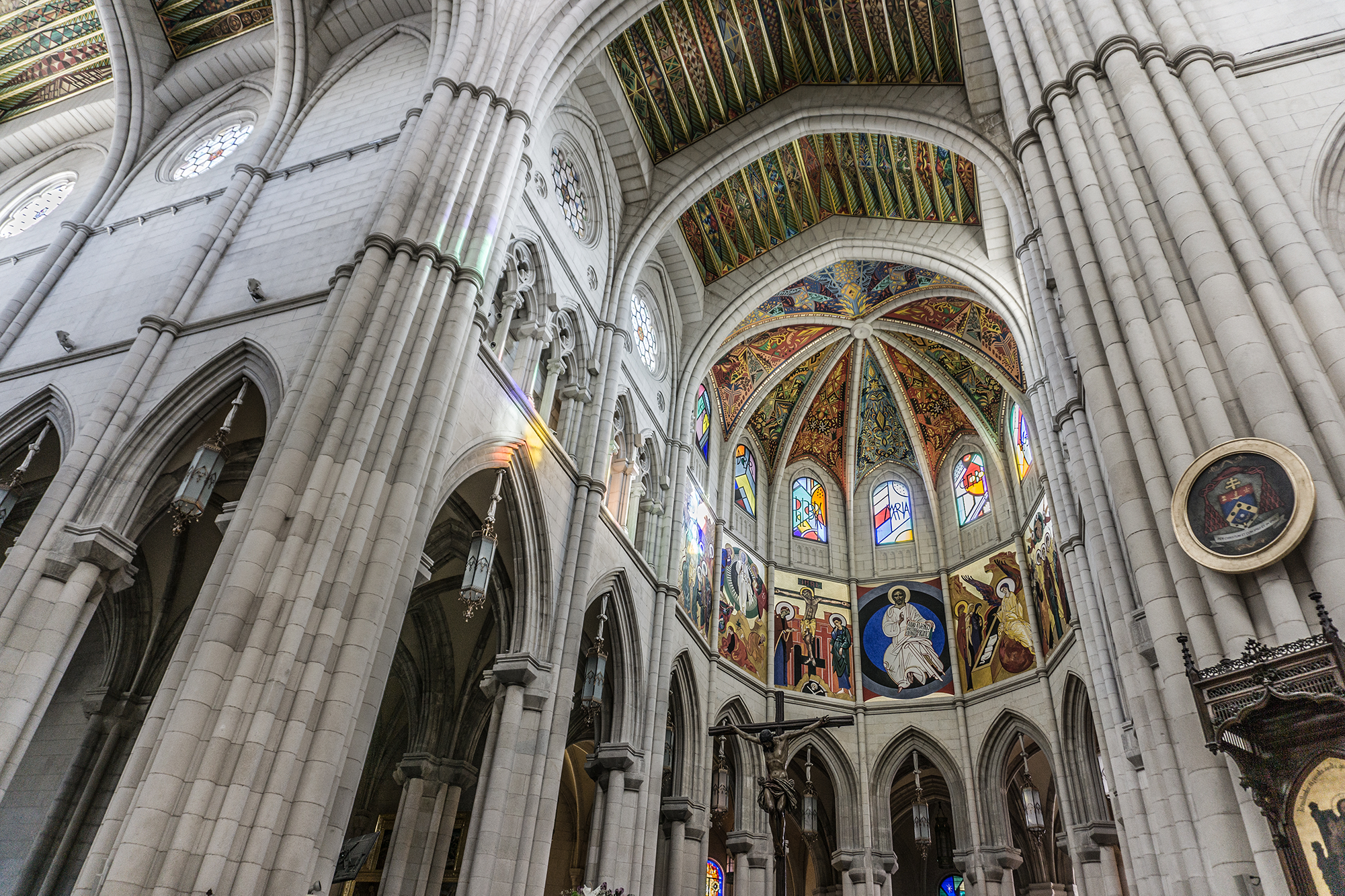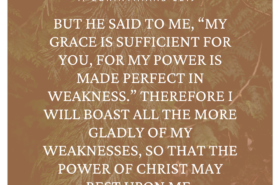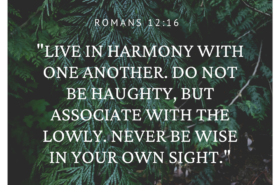
It’s a terrifying, even depressing time to be alive. We live in a world divided. Not only is there division, but there is tragedy. And we can’t even agree on repairing the tragedy. When we should be united against evils – shootings, disease, poverty – we find ways to have anger against people who are trying to restore the good that was lost and prevent it from being lost again, instead of directing our anger against the evil that caused it in the first place.
“You can endure a tragedy, but it doesn’t have to be hell,” Jordan Peterson, professor and clinical psychologist said. Tragedy is suffering evil outside of our control. Hell, by his definition, is evil that we create for ourselves in the midst of the tragedy.
And that is somehow what we have managed to do. In the tragedies, we’ve created this reflection of hell.
Between these tragedies and hells, we can’t help but face the question:
“How can God be good or even exist when there is so much evil in the world?”
And yet, we can see beauty. In creation, in people, even in society, we see glimpses of peace and purity and love. If that good can exist, how could God allow it to get to a point of such corruption and horror? How could this deity, who claims to be good and loving and perfect, seem so silent in an evil, unloving, fallen world?
In The Beginning
During the Nazi regime, among the many evils of lives being lost, people being tormented and experimented on, and ideologies forever corrupting people’s outlook even to this day, one of the tragedies was destroyed beauty.
In order to complete his vision for how the world should look, Adolf Hitler carried out one of the most destructive art purges in history, seeking out art he deemed unworthy of existence and burning it. In his world, the world that he wanted to rule over, this art was “degenerate.”
This was a special kind of tragedy. Creativity was smothered. Masterpieces met with the evilest of the evil, a political party that decided it was the final authority on what was good and bad. They decided how the world of art – a world of innovation, progress, and beauty – should operate. The purity of expression met with the depravity of hatred.
In Genesis 1, we witness the introduction of a similar series of events. A creator takes a blank canvas of formlessness and begins to paint. As he paints, he says to himself at every step:
“It is good.”
“And God saw that the light was good.” 1:4
“God called the dry land Earth, and the waters that were gathered together he called Seas. And God saw that it was good.” 1:10
“The earth brought forth vegetation, plants yielding seed according to their own kinds, and trees bearing fruit in which is their seed, each according to its kind. And God saw that it was good.” 1:12
“And God made the two great lights—the greater light to rule the day and the lesser light to rule the night—and the stars. And God set them in the expanse of the heavens to give light on the earth, to rule over the day and over the night, and to separate the light from the darkness. And God saw that it was good.” 1:16-18
“So God created the great sea creatures and every living creature that moves, with which the waters swarm, according to their kinds, and every winged bird according to its kind. And God saw that it was good.” 1:21
“And God made the beasts of the earth according to their kinds and the livestock according to their kinds, and everything that creeps on the ground according to its kind. And God saw that it was good.” 1:25
“And God saw everything that he had made, and behold, it was very good.” 1:31
Then, after he was finished, the artist did not keep the artwork to himself. He shared it with the untrained eye because he wanted them to know beauty. He exposed his work to potential corruption, because he knew sharing his art would further display his love in a way that keeping it to himself couldn’t. He lavished his creation on the created, as a gift.
It was good.
He even went a step further and allowed them to name his creation (Genesis 2:19), care for and cultivate it, and enjoy everything it had to offer (Genesis 1:29-30).
But his creations were not satisfied to revel in this paradise. The enemy of the artist, the ultimate evil, showed his face and tempted the creation to “complete” the picture of ultimate good by polluting it. He made them question the goodness of the artist, and offered the promise that the creation could be like the artist. They could be in control. This creation was not, in fact, good, evil claimed.
The artist, although never committing evil, knew what it was, but did not see fit to include its destructive display in his original work. His picture was as He intended, but the creation chose to try to claim sovereignty over the art.
The ultimate evil entered the ultimate good and attempted to destroy it.
And we, the created, continue the legacy of destruction. We try to fix it, but evil still rears its ugly head because we are not equipped to restore creation. We were never the artist, as much as we want to be.
But the artist isn’t finished. This broken world isn’t the final masterpiece.
The Masterpiece
Fast forward to the end of the Bible. We find the end of this story, this tale of polluted goodness, to be one of hope.
Then I saw a new heaven and a new earth, for the first heaven and the first earth had passed away, and the sea was no more. And I saw the holy city, new Jerusalem, coming down out of heaven from God, prepared as a bride adorned for her husband. And I heard a loud voice from the throne saying, “Behold, the dwelling place of God is with man. He will dwell with them, and they will be his people, and God himself will be with them as their God. He will wipe away every tear from their eyes, and death shall be no more, neither shall there be mourning, nor crying, nor pain anymore, for the former things have passed away.”
Revelation 21:1-5
And he who was seated on the throne said, “Behold, I am making all things new.” Also he said, “Write this down, for these words are trustworthy and true.”
God made the world good, and He promises that He will remake it all. The corruption will be forgotten. Satan will be locked out from attempting to destroy the new creation.
How do we know? What promise do we have that the enemy, sin, and death are truly defeated and will never re-enter this new creation?
We have Jesus. God is life; Satan is death. And to conquer death, God sent Jesus, His son, to endure the death that we deserved – that we had chosen at the beginning of time – to shut its consuming mouth once and for all.
Because only the ultimate life could conquer ultimate death.
Since therefore the children [humanity] share in flesh and blood, he himself likewise partook of the same things, that through death he might destroy the one who has the power of death, that is, the devil, and deliver all those who through fear of death were subject to lifelong slavery.
Hebrews 2:14-15
Jesus Christ is our promise. He has opened the gates to life and shut the doors to death. In fact, He Himself became the gate (John 10:9) so that we could have the life only He could live.
Our way out of this world of evil and suffering is through that gate. There is no other way to gain entry to the final masterpiece. By recognizing Jesus as the only way and the only one who can save us from ourselves, we take on the life that we could not live on our own – the perfectly good life of the artist.
This world as it is is not the masterpiece. The life given by the artist and the world to come is.
For now, we live that blessed life in the promised hope of the completed masterpiece to come.
The In-Between
That still doesn’t answer the question: why does the artist allow His work to continue to be destroyed? Why did He even allow that option in the first place?
The answer seems contradictory and completely unsatisfying: because He is good. But let’s examine this further.
A component of love is freedom. It is strange; we complain that God is cruel in allowing evil brought on by the hands of humanity, and yet we recoil at the idea of having no autonomy.
If God were to bring justice now, all those not in Christ, however good their morality, however little pain they’ve caused others, would face the same end: condemnation. God saves the murderer and God saves the saintly. His delay is mercy; His waiting is patience.
Admittedly, there is tension here. We cannot help but question the goodness of God as we watch the world around us crumble. We have fleeting moments where autonomy feels like the worse option. I have thought this myself – just automatize me and the rest of the world; at least then we will live free of suffering.
Trusting the transcendent, omniscient wisdom of the Lord is difficult (an understatement, I realize).
But let us also remember that we are not merely creations of the Lord, but beings made in relationship with Him. We all have some form of relationship with God – be it an enemy of Him, or friend, child, and servant – and relationship is neither possible nor pleasant when hands are forced. (This is not a comment against predestination; that is in a different category, an article in and of itself.) In relationship with God, we are learning about Him over the course of our lives. We draw near and fall away, we ask questions and share burdens. We laugh and praise and thank and give. We exchange thoughts and experiences. And when we suffer, we suffer together – not alone.
Our God subjected Himself to the suffering of the fallen work, at the hands of evil, so He suffers with us – He is not distant in the calamity, He is near and shaping and preparing us for the masterpiece. We walk with Him, as He leads the way by just a few short steps, showing us the way He took through death, claiming victory over it, into new life. This getting-to-know-you period with God will culminate in what is compared to a wedding (Revelation 19:7), an adoption (Galatians 4:4-5), a coronation (Romans 8:17).
He is the image of the invisible God, the firstborn of all creation.
Colossians 1:15
Let us follow our brother and Lord into the new earth. And even further, let us be conformed into His image – the image of God – the true Human.
For those whom he foreknew he also predestined to be conformed to the image of his Son, in order that he might be the firstborn among many brothers.
Romans 8:29
This is the only way we will ever be able to exist there, in the perfect creation: unless we are made into the image of this perfect Person, a Person with a will that is one with the Father (John 6:38), we will have a will that chases rebellion and attempts to curse His gift to us with evil. With a will that is conformed and united to His, we will have freedom, and in our freedom, no longer merely good but perfected, we will desire to rejoice in and cultivate the Artist’s vision. We will love the Artist and all He does. We will truly work within the masterpiece as He perfectly intends and loves for us to do.
No evil can exist when all are willingly and gloriously one with the Christ.
“Who has known the mind of the Lord
1 Corinthians 2:16
so as to instruct him?”
But we have the mind of Christ.
This is not the masterpiece. We await it, we are in the final chapter before it is revealed. It was created by the Father, bought and redeemed by the Son, and being regenerated by the Spirit from within, soon to be brought into the fullness of the Godhead for eternity.
That was the plan of the Artist all along, in every evil, in every calamity, in every suffering and death. The masterpiece is still being made.


